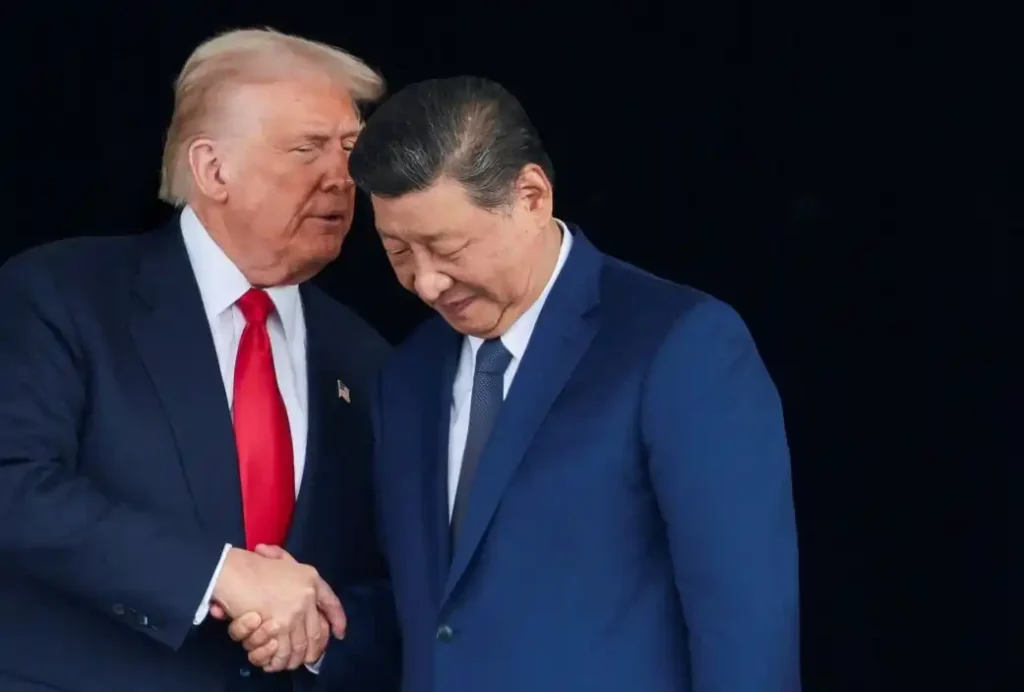New Delhi: The 2025 Asia-Pacific Economic Cooperation (APEC) summit in South Korea concluded with renewed pledges for open trade and inclusive growth, but it was the landmark meeting between the U.S. President Donald Trump and Chinese President Xi Jinping that defined the event. Their first in-person meeting since 2019, held on the sidelines in Busan, marked a turning point in the tense relationship between Washington and Beijing.
After years of escalating tariffs and diplomatic hostility, both leaders struck a deal to ease economic friction. The United States announced a 10 percent reduction in tariffs on Chinese imports, including those linked to the export of fentanyl-related substances, while China agreed to extend its suspension of export controls on rare earth minerals for another year. The mutual concessions are expected to stabilize supply chains vital to global technology, defense, and energy sectors.

The Rare Earth Deal and Its Strategic Importance
Rare earth elements — a group of 17 critical minerals used in everything from electric vehicles and smartphones to missile systems — remain one of China’s most powerful trade levers. By pausing export restrictions, Beijing signaled a willingness to cooperate on an issue that has long strained relations with the West. The move ensures steady access to materials essential for U.S. manufacturing, defense industries, and emerging technologies.
President Trump framed the Busan meeting as a “G-2 moment,” reviving an idea introduced by American economist C.F. Bergsten that envisioned the U.S. and China as joint stewards of global economic order. The G-2 model emphasizes shared responsibility for global governance, trade balance, and crisis management.
However, analysts say this cooperative tone could also herald a new bipolar dynamic, where the two nations dominate international decision-making. Such a shift might sideline regional initiatives like the Quad and AUKUS, designed to balance China’s rise, and could challenge the role of developing nations seeking a more multipolar world order.
India’s Position Amid the U.S.–China Thaw
For India, the evolving dynamic between Washington and Beijing brings mixed implications. A closer U.S.–China partnership could reduce America’s reliance on India as a counterbalance to China’s power in the Indo-Pacific, potentially emboldening Beijing’s assertiveness on the Himalayan border. At the same time, it underscores India’s need to strengthen self-reliance in technology and supply chains while deepening ties with partners like Japan, Australia, and the European Union.
APEC’s Vision for Inclusive Growth
While the Trump–Xi summit dominated headlines, the APEC forum itself emphasized regional cooperation and economic inclusivity. In a joint declaration, the 21 member economies — including Japan, Canada, South Korea, and Australia — reaffirmed their commitment to “trade and investment that benefits all.” The document highlighted support for market-driven growth, capacity-building initiatives, and collaborative approaches to managing demographic challenges and artificial intelligence.
South Korean President Lee Jae Myung, hosting his first major global event since taking office in June, warned that “the free trade system is experiencing strong turbulence” and called for renewed unity to confront mounting economic uncertainty. His remarks reflected widespread concern that the rise of protectionism and strategic rivalry could further destabilize the global economy.
Difficult Consensus at the Summit
Despite the generally positive tone, the final APEC declaration avoided explicit mentions of the World Trade Organization or multilateral trade systems. Trade expert Deborah Elms, from Singapore’s Hinrich Foundation, described the negotiations as “a miracle,” saying officials worked late into the night to find wording acceptable to all members. The omission of traditional multilateral commitments revealed lingering divisions between economies favoring open markets and those prioritizing national protectionism.
Xi Jinping’s Diplomatic Outreach
Following Trump’s early departure, Xi Jinping emerged as the central figure of the Gyeongju sessions. In his address, Xi said the world was facing “changes unseen in a century” and urged leaders to “pull together” in uncertain times. The Chinese leader sought to position Beijing as a stabilizing force in global trade, presenting China as a champion of free exchange and multilateral dialogue.
Yet, skepticism remained among several Asian nations wary of China’s assertive behavior in regional disputes. Despite China’s rhetoric supporting open trade, its use of export controls and coercive diplomacy in the past continues to shape how neighboring countries engage with Beijing.
Representing the U.S. during the remaining sessions, Treasury Secretary Scott Bessent reiterated that Washington’s trade rebalancing efforts aimed to strengthen global economic resilience rather than isolate partners.
Key Bilateral Meetings on the Sidelines
Xi used the summit to rebuild diplomatic relationships with several major economies. His most high-profile meeting was with Japan’s new Prime Minister Sanae Takaichi, who became Japan’s first female leader earlier this year. Both leaders expressed cautious optimism about improving ties, with Takaichi emphasizing cooperation on common interests despite unresolved disputes over maritime boundaries and trade restrictions. Xi urged Tokyo to treat China as a partner, not a rival, and to “look toward the future rather than the past.”
Another key engagement was with Canadian Prime Minister Mark Carney, as both countries attempted to reset relations strained under previous leadership. Carney, aiming to double Canada’s non-U.S. exports within the next decade, accepted Xi’s invitation to visit China and emphasized the importance of rebuilding trust. The two sides discussed ongoing trade issues, including China’s anti-dumping duties on Canadian canola and Canada’s 100 percent tariff on Chinese electric vehicles.
Xi also met Thai Prime Minister Anutin Charnvirakul, agreeing to accelerate work on a long-delayed high-speed rail link and strengthen joint efforts to combat cross-border crime. Anutin called the talks a “revival” of cooperation after a period of limited engagement.
South Korea’s Balancing Act
As the APEC host nation, South Korea found itself walking a diplomatic tightrope between its security alliance with the United States and its economic interdependence with China. Nearly one-fifth of South Korea’s exports in 2024 went to China, worth over $133 billion, while exports to the U.S. reached $127.8 billion.
During his bilateral meeting with Xi, President Lee called for closer communication and collaboration to restart dialogue with North Korea and maintain peace in Northeast Asia. “The importance of peace and stability in the region cannot be overstated,” Lee said, proposing a shift toward a “horizontal and mutually beneficial” relationship with Beijing. Xi described South Korea as an “inseparable cooperation partner” and urged the two nations to manage their differences through diplomacy.
Business Deals and Economic Momentum
The APEC summit also saw major corporate developments. U.S. semiconductor giant Nvidia finalized a $3 billion joint venture with Hyundai Motor Group to develop artificial intelligence systems. Nvidia CEO Jensen Huang, fresh from his company’s record valuation of $5 trillion, expressed hope that improving U.S.–China relations could eventually allow sales of advanced AI chips to China, though such decisions remain subject to U.S. policy.
The International Monetary Fund, which had previously downgraded its global growth forecast following U.S. tariff announcements earlier in the year, revised its outlook upward, citing the resilience of global markets and improving investor sentiment.
India’s Strategic Advances
Away from the APEC spotlight, India secured two major strategic gains during the same week. The U.S. granted a six-month sanctions waiver allowing India to continue operations at Iran’s Chabahar Port, a vital trade link connecting India to Central Asia and Afghanistan without passing through Pakistan. The decision revived an exemption first granted in 2018 but withdrawn earlier this year as part of Washington’s pressure campaign on Tehran.
In a separate development, three Indian firms — Continental India, Hitachi India, and Jay Ushin — received Chinese licenses to import rare earth magnets. The Ministry of External Affairs confirmed that the move would ease supply challenges created by Beijing’s earlier export restrictions and ensure smoother access to critical materials.
Ongoing Regional Tensions
While Asia-Pacific leaders focused on trade, other regions grappled with instability. In the Middle East, the Gaza ceasefire that began on October 10 came under renewed strain after an Israeli soldier was killed in Rafah, prompting retaliatory strikes that left over 100 people dead. Despite the escalation, the fragile truce has so far held amid global diplomatic efforts to prevent a wider conflict.
In South Asia, Pakistan and Afghanistan agreed in Istanbul to extend their ceasefire by one week following talks mediated by Türkiye and Qatar. The two nations pledged continued dialogue to control cross-border militancy and stabilize relations after months of violent clashes.
Cautious Optimism for Global Cooperation
The 2025 APEC summit in Busan and Gyeongju reflected both hope and caution. The Trump–Xi truce offered a glimpse of renewed pragmatism between Washington and Beijing after years of confrontation. While the tariff reductions and rare earth agreement provide temporary relief to global markets, the deeper strategic competition between the two powers remains unresolved.
For now, APEC 2025 has underscored that despite political rivalries and economic uncertainty, global interdependence remains the cornerstone of international stability. The world’s major powers appear willing to cooperate — at least for now — to safeguard prosperity in an era defined by complexity, competition, and change.
FAQs
1. What was the main outcome of the Trump–Xi meeting at the APEC 2025 summit?
The key outcome was an agreement to ease trade tensions between the United States and China. The U.S. reduced certain tariffs on Chinese imports by 10 percent, particularly those linked to fentanyl-related goods, while China extended for one year its suspension of export controls on rare earth minerals — critical materials for defense and technology industries.
2. Why is the rare earth minerals deal between the U.S. and China significant?
China dominates global production and processing of rare earth elements, which are essential for manufacturing electric vehicles, smartphones, missiles, and renewable energy systems. The one-year pause on Chinese export controls ensures continued supply to U.S. and global markets, easing fears of shortages that could disrupt key industries.
3. What is the concept of G-2 that President Trump referred to?
The term “G-2” was coined by economist C.F. Bergsten in 2005 to describe a global framework where the U.S. and China act as co-managers of international stability. Trump’s use of the term during the summit suggests a renewed vision of bilateral cooperation between the two superpowers on trade, governance, and global economic issues.
4. What were the major highlights of the 2025 APEC summit in South Korea?
The summit focused on promoting trade and investment that benefits all member economies. Leaders pledged to strengthen cooperation on artificial intelligence, tackle demographic challenges, and maintain open markets. South Korean President Lee Jae Myung urged collaboration amid global economic uncertainty, while Xi Jinping called for unity in navigating what he described as “changes unseen in a century.”
5. How does the U.S.–China truce affect India and the wider region?
The U.S.–China rapprochement could reduce Washington’s dependence on India as a strategic counterweight to China in the Indo-Pacific. However, India achieved its own diplomatic success during the same week, securing a six-month U.S. sanctions waiver for the Chabahar Port project in Iran and gaining licenses to import rare earth magnets from China — moves that strengthen its regional and industrial position.

